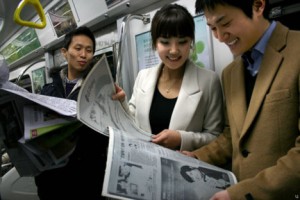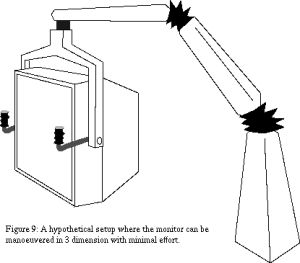@lindastone published this short post titled The Look & Feel of Conscious Computing, which I found compelling and resonant with thoughts that have been rattling around in my head for awhile:
“With a musical instrument, it’s awkward at first. All thumbs. Uncomfortable. Noise. With practice, instrument and musician become as one. Co-creating music. So it will be with personal technology. Now, a prosthetic of mind, it will become a prosthetic of being. A violinist with a violin. Us with our gadgets, embodied, attending as we choose.”
For context, Linda also pointed me toward another of her posts, A new era of post-productivity computing? where she closes with the question
“How do we usher in an era of Conscious Computing? What tools, technologies, and techniques will it take for personal technologies to become prosthetics of our full human potential?”
I’ve wrestled with similar questions in the past:
“In the arts, we speak of a talented and communicative practitioner as a virtuoso. The virtuous performer combines technical mastery of her medium with a great depth of human expressiveness, communicating with her audience at symbolic, intuitive and emotional levels. Can we imagine a similar kind of virtuosity of communication, applied to domains that are not traditionally considered art? Can we further make this possibility accessible to more people, allowing a richer level of discourse in the walks of everyday life?
“When groups of musicians play together, they establish communication channels among themselves through the give and take of listening and leading. Great ensemble players know how to establish a state of flow, a groove, where the music takes on a vitality and life of its own, greater than the sum of the individual rhythms, pitches and timbres. What are the conditions that make such a group ‘chemistry’ possible? Could we capture that essence and apply it to the work of organizations, the building of communities, the life of families?
“As information technologies increasingly become integral to our activities, the information we use, even to our ways of thinking and perceiving, we must confront some difficult, elusive notions about the relationships between people and their tools. For instance, in what sense can the technology enhance creative, playful thinking — are we having fun? What about beauty, inspiration, spirituality, mystery? These are qualities for which humans have striven over our entire history; shall we subjugate them in the name of efficiency, convenience and immediacy? Do the artifacts we make allow people space for reflection and insight, or merely add to the numbing cacophony of digital voices demanding our attention? Is it strange to ask such questions? Not at all. The economics of information technologies seem to dictate a future where more and more of our lives will be mediated by networks and interfaces and assorted other paraphernalia of progress. We must recognize the importance of such uniquely human concerns and integrate them into our vision, or risk further dehumanization in our already fractured society.”
Okay, that was from 1994, so where are we on this? I have to say, it seems like mainstream computing has advanced very little in these areas. Apple has good intentions, and the iPad actually does a nice job of getting out of the way, letting you interact directly and physically with individually embodied apps. It’s the best of the bunch, but the iPad is no violin, no instrument of human expression. Certainly the current crop of PCs, netbooks and phones are no better.
There are a few non-mainstream computing paradigms that give me hope for a conscious computing experience. The Nike+ running system, my favorite example of embodied ubi-media, creates an inherently physical experience augmented with media and social play. Nike+ doesn’t have a broadly expressive vocabulary, but it does bring your whole body into the equation and closes the feedback loop with contextually suitable music and audio prompts.
At its best, Twitter starts to feel like a global jam session between connected minds. The rapid fire exchange of ideas, the riffing off others’ posts, the flow of a well-curated stream can sometimes feel uniquely expressive. Yes, it is primarily a mental activity and mostly disembodied, but the occasional flashes of genuine group chemistry are wonderfully suggestive of the potential for an interconnected humanity.
For me, the most interesting possibilities arise from games. There are the obvious examples of physical interaction and expression that the Wii and Kinect deliver primarily for action games now, but with time a broader range of immersive and reflective experiences (is Wii Yoga any good?). I’m also thinking of the emerging genre of out-in-the-world games like SF0, SCVNGR and Top Secret Dance Off that send you on creative, social missions involving physicality, play, performance and discovery. Finally there is the next generation of “gameful” games, as proposed by Jane McGonigal:
What is Gameful?
We invented the word gameful! It means to have the spirit, or mindset, of a gamer: someone who is optimistic, curious, motivated, and always up for a tough challenge. It’s like the word “playful†— but gamier! Gameful games are games that have a positive impact on our real lives, or on the real world. They’re games that make us:
- happier
- smarter
- stronger
- healthier
- more collaborative
- more creative
- better connected to our friends and family
- more resilient
- better problem-solvers
- and better at WHATEVER we love to do when we’re not playing games.
I think the future of expressive, improvisational, conscious computing will be found at the intersection of personal sensing tools like Nike+ and Kinect, collective action tools like Twitter, and the playful engagement of gameful games. It won’t look like computing, and it won’t come in a box. It won’t be dumbed down for ‘ease of use’, it will be flowing experiences designed to make us more complex, capable and creative. It will augment our humanity, as embodied individuals embedded in a physical and social world.


